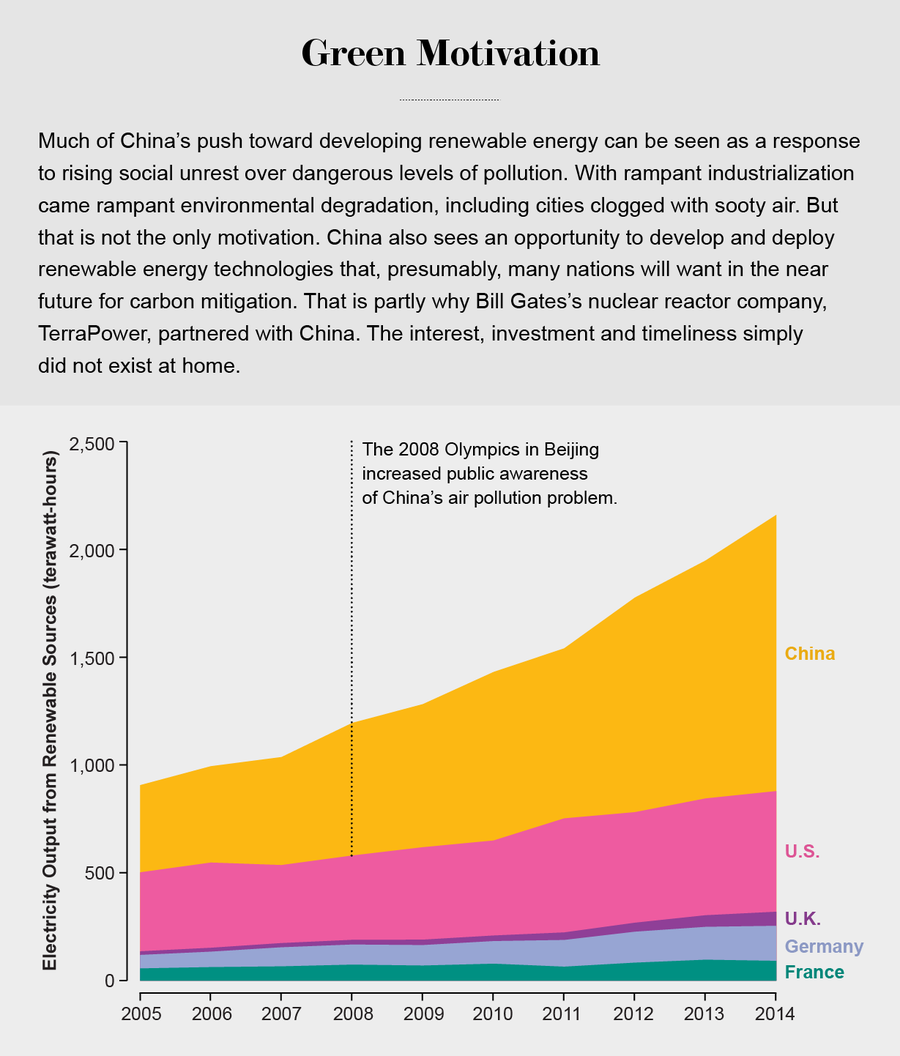In June, when U.S. president Donald Trump announced he would withdraw from the Paris climate accord, all eyes anxiously looked to China. Without participation from the nation that historically has been the world's biggest polluter, pundits worried President Xi Jinping would see a way out of his country's carbon-reduction pledge, and the deal would unravel. Instead Xi, a former chemist, staunchly reaffirmed his country's commitment to investing in renewable energy and meeting its emissions goals. In fact, China is already blowing past some of its targets.
Innovating with solar cells and next-generation nuclear reactors is just one part of China's massive investment in scientific research. If technological development is increasingly an engine for economic growth and national strength, then support for basic research and applied science is its fuel. For much of the past century the U.S. maintained dominance in this arena. But as the current administration attempts to reinvigorate the coal industry, slashes research budgets, questions the value of the Environmental Protection Agency and discounts evidence-based policy making—willfully ceding the mantle of global scientific leadership—China is rushing to fill the void, with potentially profound consequences for the world.
“The development of Chinese technology will have benefits for everyone,” says Robert Daly, director of the Kissinger Institute on China and the United States at the Woodrow Wilson International Center for Scholars in Washington, D.C. “But as China increases its comprehensive national power, it is increasingly able to shape a global environment that is more amenable to the goals of the Chinese Communist Party and its illiberal ideas about how individuals, institutions and information relate to the state.” That includes the thorny issues of regulation and intellectual property, which are much looser in China than in the West.
On supporting science journalism
If you're enjoying this article, consider supporting our award-winning journalism by subscribing. By purchasing a subscription you are helping to ensure the future of impactful stories about the discoveries and ideas shaping our world today.

Credit: Amanda Montañez; Source: International Energy Agency
The backbone of China's rise in this realm is its 13th “Five-Year Plan,” which counts on scientific research and technology to be key drivers of economic growth. The result is a staggering $1.2 trillion devoted to R&D between 2016 and 2020. Of that, $373 billion is slated to go to renewable energy alone. Additionally, a 10-year “Made in China 2025” initiative supports progress in areas such as artificial intelligence, cloud computing, robotics, biotechnology and electric vehicles.
These plans are bearing fruit. In terms of relative purchasing power, China currently spends more on research and development than the European Union. And according to the Organisation for Economic Co-operation and Development, it is on track to surpass U.S. spending by 2020. In the past decade China's contributions to the world's total volume of research articles has surged from 13 to 20 percent, and today only the U.S. generates more high-quality scientific papers. It now lays claim to the world's longest electric high-speed rail network, the largest radio telescope and the top two fastest supercomputers. It is launching a carbon-emissions cap-and-trade market this year that will dwarf the planet's largest one, in the E.U. Also the top producer of rare earth metals for high-tech manufacturing, China leads the globe in solar, wind and hydropower capacity and is or will soon be the strongest market for goods such as electric cars, nuclear reactors, smart devices, industrial robots and 3-D printers.
China still faces obstacles. Daly says its higher-education system is “lousy at spurring creative thinking.” Writing in 2016 in Nature, Wei Yang, president of the National Natural Science Foundation of China, acknowledged criticisms “that China's universities have become paper mills induced by metrics that value quantity over quality.” Yet China continues to establish sweeping science programs and build gargantuan facilities. One prominent example is Shenzhen-based BGI (formerly the Beijing Genomics Institute), by many metrics the largest gene-sequencing company in the world. BGI's 5,000 workers in 47 laboratories aim to sequence the genomes of as many organisms as possible, from ancient hominins to rice to giant pandas. In July, after a successful pilot project, it announced plans to sequence 10,000 plant and microbe genomes—potentially unleashing a flood of data that could revolutionize the field.
China's motivation to lead in science goes beyond prestige and revenue. Consider the case of its Quantum Experiments at Space Scale (QUESS) satellite, a spacecraft the nation launched in 2016 as part of a broader program of space science missions. In low Earth orbit, QUESS's specialized system of lasers and optics tests the fundamentals of quantum mechanics. But the satellite's most noteworthy achievement, reported this past June, involved the first ever transmission of entangled photons to ground stations separated by a distance of 1,200 kilometers. A network of such satellites could form the backbone of an unhackable quantum communications network.
Some in the West may view China's growing power as a geopolitical threat. It is true that “China is undertaking a series of massive state-led investments that happen to be occurring while the U.S. is losing its appetite for risk,” says Ben Shobert of the National Bureau of Asian Research in Seattle. But China's R&D-fueled rise is, at this point, inevitable, says Michael O'Hanlon of the Brookings Institution in Washington, D.C. “Impressive budgets for scientific research and technology development are the next stage in becoming a great power,” he adds. “It's not a phase—it's a new reality. They're going to keep pushing forward without letting up. And if I were in their shoes, I wouldn't, either.”
